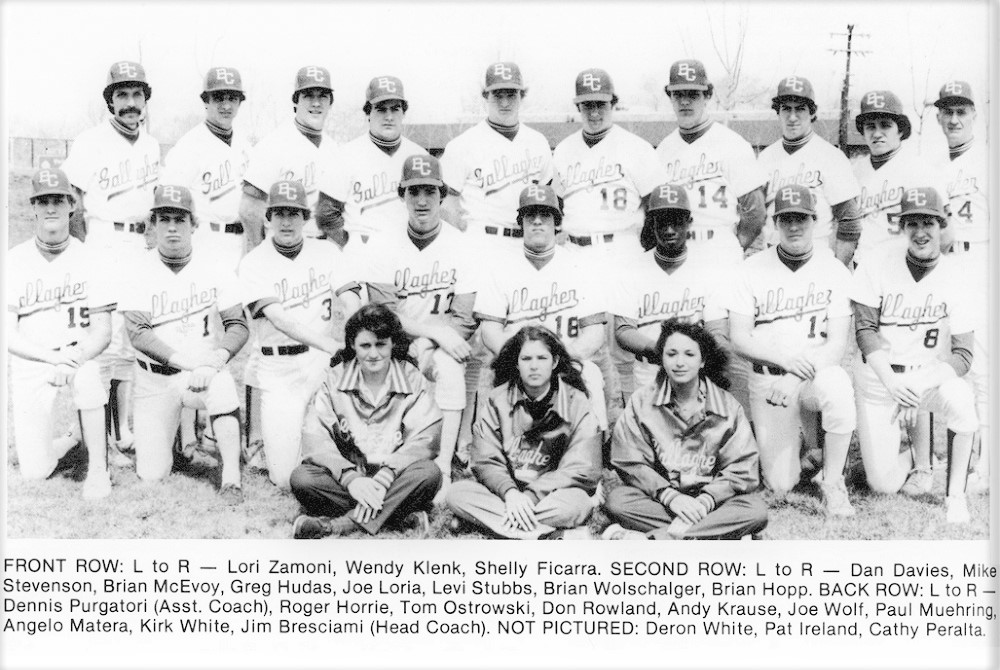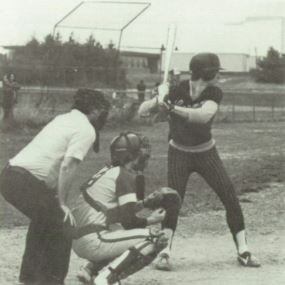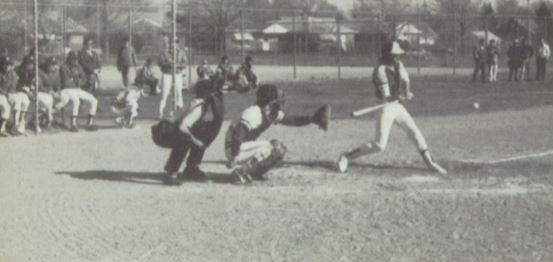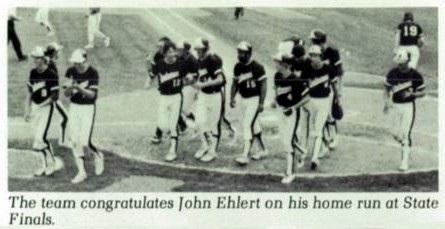
Flashback 1981: 3 Days Finally Yields 4 Baseball Champions
By
Ron Pesch
MHSAA historian
April 30, 2021
The nursery rhyme “Rain, Rain Go Away” has often served as unofficial anthem for the MHSAA’s baseball tournament, first held in the spring of 1971.
A decade after the start, downpours again turned a planned Saturday-sprint-to-the-finish into a three-day-marathon that finally wrapped up on Tuesday, June 16, 1981.
In the end, the 10th MHSAA Boys Baseball Tournament did feature a few ‘firsts.’ The finish of the season marked the first year that championship games for each of the Association’s four classes were scheduled for play at a single site. Previous championship action saw each class play its title game in a different city across the state.
Alumni Field at Central Michigan University served as host. Home of the Chippewas, the site served as an impressive backdrop, as the stadium had been recently renovated thanks to fundraising work by Mount Pleasant insurance businessman Jack Weisenburger, who had played five years of professional baseball in the Boston Braves organization, and nationally-known beloved sportscaster Dick Enberg, a CMU alumnus.
CLASS A
Roger Horrie’s 10th-inning two-out hit up the alley in left center scored freshman pinch runner Deron White from third base, giving Harper Woods Bishop Gallagher a 7-6 walk-off victory over Flint Carman.
 The smash, coming off Jeff Hamilton’s two-ball, two-strike pitch, was welcome relief to Lancers coach Jim Bresciami, whose team had stranded 17 runners on base prior to the game winner. Gallagher had loaded the bases in both the seventh and ninth innings, but was unable to score.
The smash, coming off Jeff Hamilton’s two-ball, two-strike pitch, was welcome relief to Lancers coach Jim Bresciami, whose team had stranded 17 runners on base prior to the game winner. Gallagher had loaded the bases in both the seventh and ninth innings, but was unable to score.
“Roger is our best bunter,” Bresciami told Detroit Free Press sportswriter Mick McCabe, “but we already had a man thrown out at the plate on a bunt so we just let him swing away, and the good Lord let it drop.” Horrie had walked three times and bunted twice earlier in the game.
The contest, twice postponed because of storms, was finally played on Tuesday.
Hamilton (who later played for the Los Angeles Dodgers from 1986-91) starred for Carman, notching three RBI on a triple in the top of the fifth inning to give Carman a 5-3 lead. Kirk White’s two-run homer for Gallagher in the bottom of the inning tied the game at five each. Darrin Lum doubled in the sixth for Carman, then scored on a single by Pat Richard to make it 6-5 before Don Rowland (later a member of University of Miami’s 1982 and 1985 NCAA championship baseball teams and a draft pick of the Detroit Tigers) tripled then scored following a sacrifice bunt by Andy Krause, again knotting the score.
With the win, Gallagher became Michigan’s first Class A team to repeat as champion, while Bresciami became the state’s first coach in Class A to win two titles.
Bresciami compiled a 545-149 record over 21 seasons at the school before retiring following the 1985 season. His teams earned three runner-up finishes (B-1974, B-1977, A-1984) and three Finals titles (A-1971, A-1981, A-1985). In addition, Gallagher returned to the Class B title game in 1986, falling to Battle Creek Lakeview, 4-3, under coach Bob Hadacz, a four-year assistant to Bresciami. Gallagher then won another crown in Class B in 1989, coached by Thomas Trompics.
CLASS B
On Monday, Bay City All Saints required only five innings to grab its second baseball title, trouncing Tecumseh 7-1. The Cougars had previously won the 1978 crown in Class C.
Tecumseh scored first, loading the bases in the top of the second inning and pushing a run across on Rex Robinson’s one-out single to grab a 1-0 lead. But it was all All Saints to follow. The Cougars responded in the bottom of the inning with an RBI single by Mark Berent, then added two more with Mike McIlhargey’s 385-foot home run shot to bump the score to 3-1. Catcher G.J. Zanotti added a solo homer in the third inning, then All Saints scored twice more in the fourth and again in the fifth. The game was called under MHSAA rules after three downpours made the field unplayable. Dave Laprairie went the distance for the win.
“For many on the team,” noted the Bay City Times years later, “their biggest game was not the state final win over Tecumseh. … To them, the real highlight was their semifinal against Mount Pleasant that was played in Bay City's Veterans Park before a crowd of nearly 3,000 people.” Mount Pleasant had finished as runner-up in Class B a year previous, and took All Saints – the top-ranked team in the Michigan High School Baseball Coaches Association (MHSBCA) regular-season final poll – to extra innings before surrendering, 10-7.
Following the postseason, All Saints shortstop Keith Miller was named to the MHSBCA Class B first-team all-state squad. (Miller would later play college baseball at Oral Roberts University, then carve out a nine-year career in the Major Leagues playing five seasons with the New York Mets and four with the Kansas City Royals.)
CLASS C
Allen Park Cabrini grabbed a 9-8 win over Buchanan in a thriller. It was the second title in three years for the Monarchs and coach Donald Oboza.
 Suspended in the third inning on Saturday with Cabrini leading 1-0, the game was resumed Monday. Cabrini added four more runs in the inning for a quick 5-0 lead. Buchanan scored twice in the bottom of the third, and then tied the contest at 5-5 in fourth, highlighted by a John Ehlert home run.
Suspended in the third inning on Saturday with Cabrini leading 1-0, the game was resumed Monday. Cabrini added four more runs in the inning for a quick 5-0 lead. Buchanan scored twice in the bottom of the third, and then tied the contest at 5-5 in fourth, highlighted by a John Ehlert home run.
The Monarchs jumped out to a 9-5 lead before storms delayed play for another hour and 35 minutes entering the seventh inning. When the game resumed, Buchanan rallied for three runs in dramatic fashion to pull within one.
“With (Buchanan) runners at first and second and no one out,” wrote Jack Walkden in the St. Joseph Herald-Palladium, “the Bucks John Ehlert hit a long drive up the alley in right-centerfield. But (Cabrini centerfielder John) Stanko went far to his left to haul down the drive over his shoulder. The play proved even more important when two of the next three Buchanan batters collected hits. If Ehlert’s drive had gotten through, Buchanan probably would have at least tied the game.”
“That guy made a heckuva play on Ehlert’s ball,” said Buchanan coach Bob Storm. “That was the ballgame.”
Cabrini’s senior righthander Tony DeMarti, “who several times left his shortstop position to pitch” due to the MHSAA’s rule that forbid one hurler from pitching more than a combined 30 outs over 10 innings in the Semifinals and Final, was “brought … back to the mound (in the seventh),” according to McCabe, “where he eventually ended the threat …”
 Cabrini first baseman Mike McKelvey finished with a single and a double, driving in three runs. Stanko notched a single and a double, scored twice and added an RBI on the day for the Monarchs. DeMarti, who had scored the eventual game winner, also earned the victory in relief – his eighth win in 12 decisions on the year.
Cabrini first baseman Mike McKelvey finished with a single and a double, driving in three runs. Stanko notched a single and a double, scored twice and added an RBI on the day for the Monarchs. DeMarti, who had scored the eventual game winner, also earned the victory in relief – his eighth win in 12 decisions on the year.
Cabrini finished with a 29-11 mark. Buchanan’s 27-5 record was the school’s best to date.
CLASS D
In the only game to finish as scheduled at CMU, Reading’s Randy Spangler (13-1) pitched a complete game, scattering five hits as the Rangers downed Mesick, 1-0.
The run came in the top of the first inning as catcher Mike Shoemaker walked, moved to second on a sacrifice by Jon Keger, and then scored on an error when Spangler’s grounder to deep short was thrown away.
Paul Ruskowski walked and stole second for Mesick in the bottom of the seventh inning, but was left on base. Coach Jack Kerspilo’s Rangers ended the year with a 26-3 record. Starter Chris McNitt took the loss for Mesick, which finished the season at 23-4.
 Ron Pesch has taken an active role in researching the history of MHSAA events since 1985 and began writing for MHSAA Finals programs in 1986, adding additional features and "flashbacks" in 1992. He inherited the title of MHSAA historian from the late Dick Kishpaugh following the 1993-94 school year, and resides in Muskegon. Contact him at [email protected] with ideas for historical articles.
Ron Pesch has taken an active role in researching the history of MHSAA events since 1985 and began writing for MHSAA Finals programs in 1986, adding additional features and "flashbacks" in 1992. He inherited the title of MHSAA historian from the late Dick Kishpaugh following the 1993-94 school year, and resides in Muskegon. Contact him at [email protected] with ideas for historical articles.
PHOTOS: (Top) Harper Woods Bishop Gallagher claimed the Class A baseball title in 1981, its second championship in the sport. (2) Future Dodgers infielder Jeff Hamilton waits on a pitch for Flint Carman in Class A. (3) John Stanko takes a cut for Allen Park Cabrini in the Class C title game. (4) Buchanan celebrates a homer by John Ehlert. (Photos collected by Ron Pesch.)

Brighton Memories Close to Henson's Heart
By
Steve Vedder
Special for MHSAA.com
November 7, 2017
Drew Henson admits he'll still sneak an occasional peak at the record book.
After 20 years and professional careers in two sports, a quick glance isn't about vanity for Henson. The former Brighton football and baseball star said he's simply curious whether his myriad records are withstanding the test of time.
"Sometimes somebody will send me (a link), and I'll look to see if anybody is getting close," Henson said. "I've got to see who is coming up."
Henson, 37, graduated from Brighton in 1998 having set 11 major hitting records, eight of which he still holds 20 years later. He's also noted among the state football record setters after throwing for 5,662 yards and 52 touchdowns during his Bulldogs career. Twice he threw for more than 2,000 yards in a season during an era right before spread offenses made doing so a much more regular occurrence. In addition, he was a standout basketball player as well at Brighton and his class’ valedictorian.
In baseball, Henson is still the all-time career leader in hits (257), doubles (68), home runs (70), grand slams (10) and RBI (290). The 70 homers is 23 more than those hit by any other Michigan high school player, including eventual major leaguers such as Nate McLouth (Whitehall), Ryan LaMarre (Jackson Lumen Christi) and Zach Putnam (Ann Arbor Pioneer). Henson drove in at least 78 runs every season sophomore through senior years. He's the state's all-time leader in RBI by 87. He also continues to hold national high school records for career RBI and grand slams.
Henson's senior baseball season is unquestionably the best ever amassed by a Michigan prep player. He set single-season records with 22 homers and 83 RBI, batted .605 and went 14-2 as a pitcher, including appearing in an MHSAA tournament game in which he struck out 20 of 21 batters, allowing batters to make contact with a pitch only twice.
 Now living in Tampa, Fla., Henson he still views the records the same way he did before he departed to play quarterback at University of Michigan and then eventually sign $3.5 and $17 million contracts with the Dallas Cowboys and New York Yankees, respectively. Henson, who once fielded ground balls beside Derek Jeter and battled Tom Brady for a starting job, played on four Brighton baseball teams that averaged about 30 wins per year.
Now living in Tampa, Fla., Henson he still views the records the same way he did before he departed to play quarterback at University of Michigan and then eventually sign $3.5 and $17 million contracts with the Dallas Cowboys and New York Yankees, respectively. Henson, who once fielded ground balls beside Derek Jeter and battled Tom Brady for a starting job, played on four Brighton baseball teams that averaged about 30 wins per year.
"A lot of factors created those opportunities for me. You don't set records like that without playing on a good team with good teammates," he said.
"We were a good hitting team from one through nine in the order. Our goal was to try and win state every year. I wouldn't have hit the homers or driven in the runs every year without my teammates. I have a lot of vivid memories of high school that are near and dear to my heart."
Former Brighton coach Mark Carrow said it's no surprise to him that Henson still owns the record book two decades after graduating. Carrow said Henson was the perfect blend of work ethic and natural talent.
"I coached for 34 years, and he was without question the best player I ever saw," Carrow said. "From the time he came to us as a freshman, it took one look at him throwing or one look hitting to know he was special.
"If there was a checklist for what you wanted in a baseball or football player, he checked the top of the box every time. He could throw 97, 98 (mph) and he could hit. He could dominate a game."
Carrow said the records are even more remarkable when you consider Henson every season would draw more than 40 walks, many intentional.
"Scouts used to come to the games, and I mean teams' top scouts," Carrow said. "And they'd say Drew was as good as they had ever seen."
Henson’s parents both were Division I college athletes, and his father Dan coached football at four Division I programs. Still, Drew’s dual sport professional career nearly took a different path as a youngster. While Henson started playing T-ball as a 5-year-old, his first love during his preteen years was basketball. Henson didn't play his first competitive football game until the eighth grade.
Considering he had interests in virtually every sport and at least in part because his father was a football coach, Henson thought of himself as a "gym rat" growing up. He would tag along to his father's practices, devour box scores in the paper and prop himself in front of the television on fall afternoons.
Much of high school athletics today is focused on specialization, but Henson said he never considered narrowing his sports to one. In fact, he encourages his young daughter to play as many sports as she can fit in.
"It never got dull for me," he said. "For a lot of kids today, it's too much for too long. You don't get a mental break. You can start to lose you."
 While Henson's high school career was one for the record books, and he helped the Wolverines to a 9-3 record and Cotton Bowl win in 2000, his professional career never took off. He was a third-round draft pick by the Yankees (97th overall) in 1998 and sixth-round pick of the NFL's Houston Texans in 2003.
While Henson's high school career was one for the record books, and he helped the Wolverines to a 9-3 record and Cotton Bowl win in 2000, his professional career never took off. He was a third-round draft pick by the Yankees (97th overall) in 1998 and sixth-round pick of the NFL's Houston Texans in 2003.
He stalled at Triple-A in the Yankees system, but did make the major leagues in 2003, singling off the Orioles' Eric DeBose for his only big league hit. He wound up retiring from baseball following the season after hitting .248 with 67 homers and 274 RBI in 501 minor league games. He was 23 years old.
In the NFL, Henson wound up making one start for the Cowboys in 2004 and in 2008 joined the Lions for a season. Henson threw one touchdown pass as a Cowboy, to Jeff Robinson in 2004.
Henson, who in July of 2015 still rated a profile in Sports Illustrated a decade after throwing his final pass in the NFL, has been asked many times about his lack of success in professional sports. Past speculation states he was rushed through the Yankees' chain, while participation in professional baseball may have stunted his football development.
Two decades after leaving Brighton, Henson said he still answers the question of which sport was actually his favorite the same way: with diplomacy.
"I've always said nothing was more fun than to play baseball, but there is also nothing like being in the huddle on the football field," he said. "It's hard to say which I liked more. You can play baseball every day, but you can only play football once a week."
The one regret Henson may harbor has to do with patience. If he had to do it all over again, Henson said he'd force himself to slow down and enjoy the process. Henson said he often felt he had to play catch-up in both sports.
"I would tell my younger self to have more patience. There were so many opportunities after my junior year (of college) that would have still been there as a senior," he said. "Because of that I wish I would've had more patience and let the process play out."
Henson said his message to youngsters who face the same challenge is simple.
"Society is so go, go, go," he said. "You just have to learn to hit the pause button. If you're always on to the next thing, you're not embracing the moment. I wish I had done more of that.
"If you like to work and put in the time, you can be successful. All that goes into it. If you have the heart and desire and pay attention to detail, you will be successful."
PHOTOS: (Top) Drew Henson starred during the fall at Brighton’s quarterback. (Middle) Henson struck out 20 of 21 batters he faced in a 1997 game against Walled Lake Western. (Below) Henson also was a basketball standout, averaging 22 points per game according to a Sports Illustrated profile published in 1998. (Football and basketball photos courtesy of Brighton High School).

